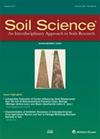Inclusion of biochar in a C dynamics model based on observations from an 8-year field experiment
4区 农林科学
Q2 Agricultural and Biological Sciences
引用次数: 7
Abstract
Abstract. Biochar production and application as soil amendment is a promising carbon (C)-negative technology to increase soil C sequestration and mitigate climate change. However, there is a lack of knowledge about biochar degradation rate in soil and its effects on native soil organic carbon (SOC), mainly due to the absence of long-term experiments performed in field conditions. The aim of this work was to investigate the long-term degradation rate of biochar in an 8-year field experiment in a poplar short-rotation coppice plantation in Piedmont (Italy), and to modify the RothC model to assess and predict how biochar influences soil C dynamics. The RothC model was modified by including two biochar pools, labile (4 % of the total biochar mass) and recalcitrant (96 %), and the priming effect of biochar on SOC. The model was calibrated and validated using data from the field experiment. The results confirm that biochar degradation can be faster in field conditions in comparison to laboratory experiments; nevertheless, it can contribute to a substantial increase in the soil C stock in the long term. Moreover, this study shows that the modified RothC model was able to simulate the dynamics of biochar and SOC degradation in soils in field conditions in the long term, at least in the specific conditions examined.基于8年田间试验观察的C动力学模型中包含生物炭
摘要生物炭的生产和应用是一种很有前途的碳(C)负技术,可以增加土壤碳固存,减缓气候变化。然而,由于缺乏长期的田间试验,人们对生物炭在土壤中的降解速率及其对土壤有机碳(SOC)的影响缺乏了解。在意大利皮埃蒙特(Piedmont)一个杨树短轮伐林场进行的8年田间试验中,研究了生物炭的长期降解速率,并对theRothC模型进行了修正,以评估和预测生物炭对土壤碳动态的影响。通过引入两个生物炭池,即活性炭池(占总生物炭质量的4%)和顽固性炭池(占总生物炭质量的96%),以及生物炭对有机碳的启动效应,对RothC模型进行了改进。利用田间试验数据对模型进行了标定和验证。结果证实,与实验室实验相比,生物炭在田间条件下的降解速度更快;然而,从长远来看,它可以促进土壤碳储量的大幅增加。此外,本研究表明,改进的RothC模型能够长期模拟土壤内场条件下生物炭和有机碳降解的动态,至少在特定条件下是这样。
本文章由计算机程序翻译,如有差异,请以英文原文为准。
求助全文
约1分钟内获得全文
求助全文
来源期刊

Soil Science
农林科学-土壤科学
CiteScore
2.70
自引率
0.00%
发文量
0
审稿时长
4.4 months
期刊介绍:
Cessation.Soil Science satisfies the professional needs of all scientists and laboratory personnel involved in soil and plant research by publishing primary research reports and critical reviews of basic and applied soil science, especially as it relates to soil and plant studies and general environmental soil science.
Each month, Soil Science presents authoritative research articles from an impressive array of discipline: soil chemistry and biochemistry, physics, fertility and nutrition, soil genesis and morphology, soil microbiology and mineralogy. Of immediate relevance to soil scientists-both industrial and academic-this unique publication also has long-range value for agronomists and environmental scientists.
 求助内容:
求助内容: 应助结果提醒方式:
应助结果提醒方式:


